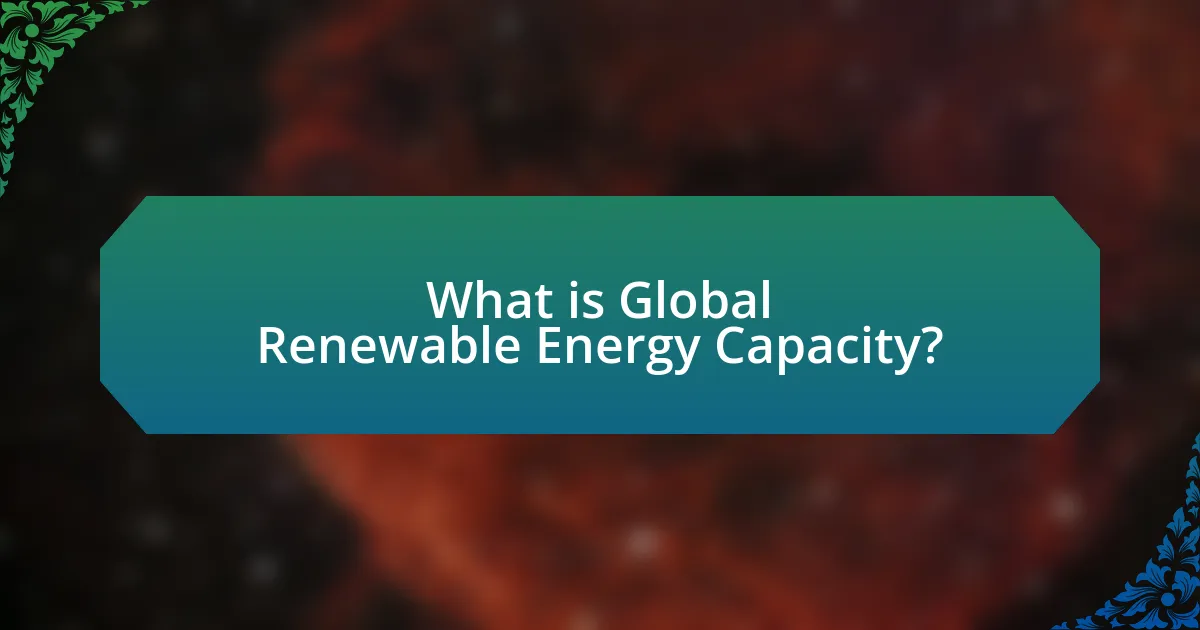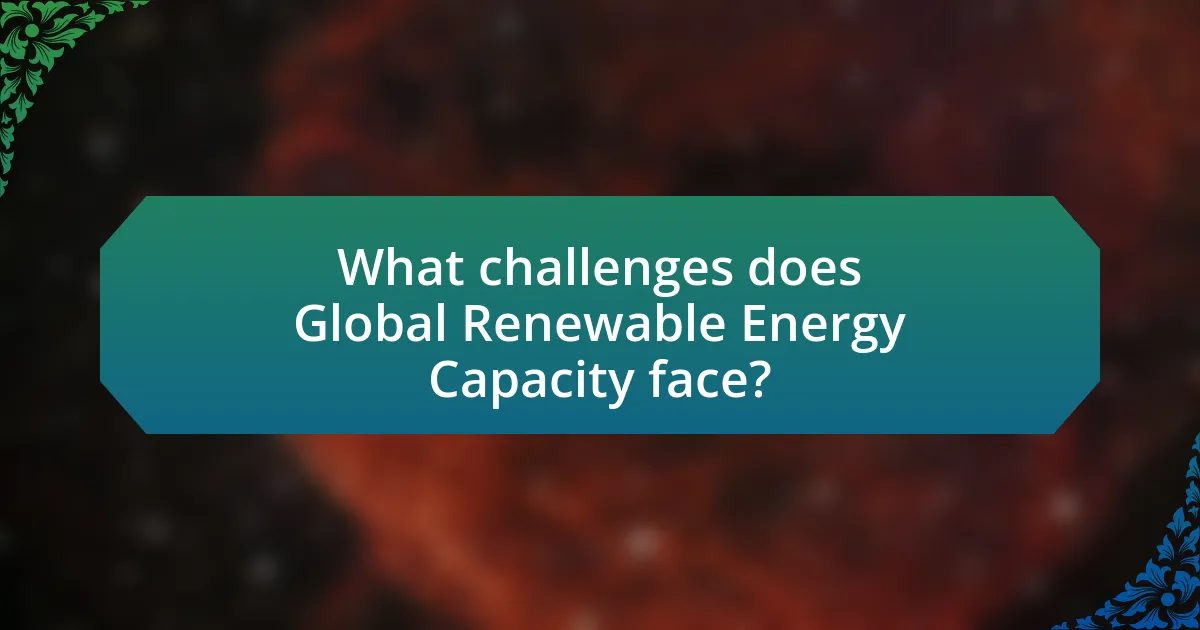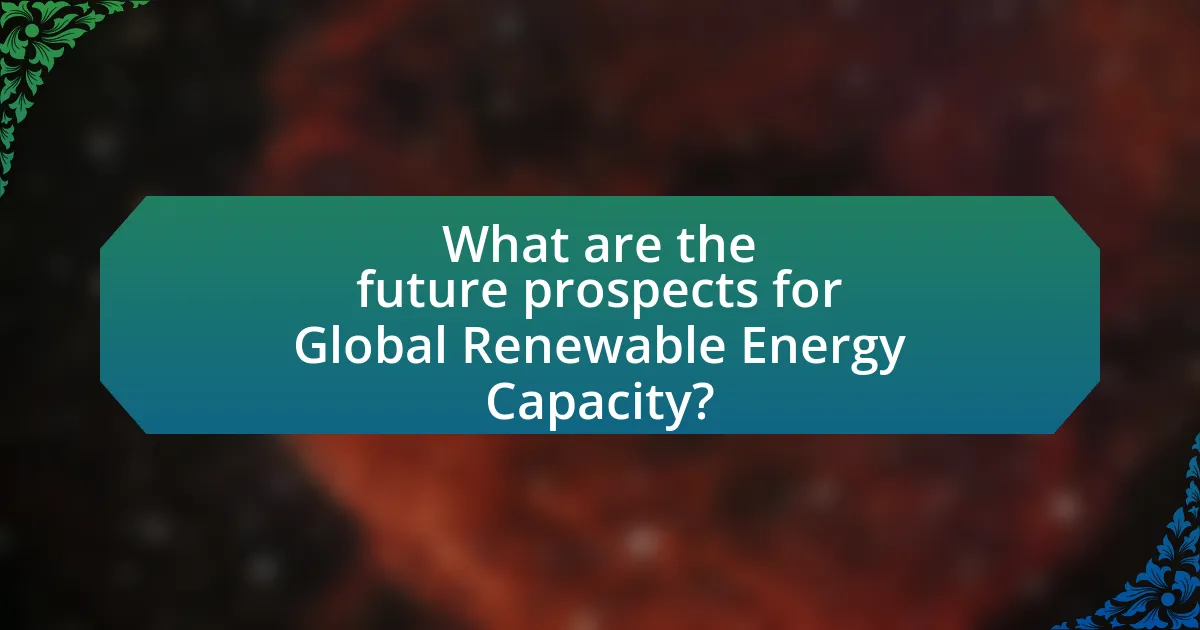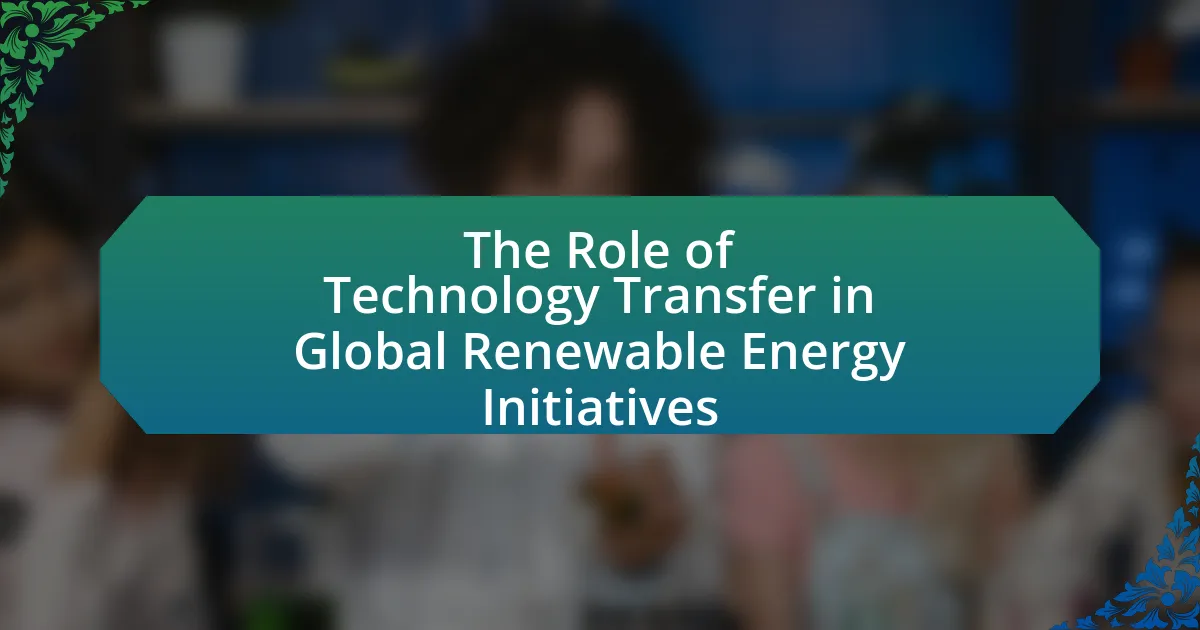Global renewable energy capacity encompasses the total energy generation potential from renewable sources such as solar, wind, hydro, geothermal, and biomass, which reached approximately 3,064 gigawatts (GW) in 2022. The article examines how this capacity is measured, the metrics used to quantify it, and the regional variations in renewable energy development, highlighting Europe’s leadership and Asia’s rapid expansion. It also discusses the importance of renewable energy in combating climate change, enhancing energy security, and the current trends driving growth, particularly in solar and wind technologies. Additionally, the article addresses the challenges faced in increasing renewable energy capacity, including financial constraints, technological limitations, and regulatory hurdles, while exploring future prospects and strategies for overcoming these barriers.

What is Global Renewable Energy Capacity?
Global renewable energy capacity refers to the total amount of energy that can be generated from renewable sources such as solar, wind, hydro, geothermal, and biomass. As of 2022, the global renewable energy capacity reached approximately 3,064 gigawatts (GW), with solar and wind energy being the fastest-growing sectors. This growth is supported by international commitments to reduce carbon emissions and transition to sustainable energy sources, as outlined in agreements like the Paris Accord. The International Renewable Energy Agency (IRENA) reported that renewable energy capacity has been increasing at an average annual rate of 8.4% over the past decade, highlighting the significant shift towards cleaner energy solutions worldwide.
How is Global Renewable Energy Capacity measured?
Global Renewable Energy Capacity is measured primarily in terms of installed capacity, which is quantified in megawatts (MW) or gigawatts (GW). This measurement reflects the total amount of electricity that renewable energy sources, such as solar, wind, hydro, and biomass, can generate under optimal conditions. For instance, the International Renewable Energy Agency (IRENA) reported that as of 2021, the global installed renewable energy capacity reached approximately 3,064 GW, indicating significant growth in the sector. This capacity measurement is crucial for tracking progress towards energy transition goals and assessing the contribution of renewables to global energy supply.
What metrics are used to quantify renewable energy capacity?
The primary metrics used to quantify renewable energy capacity include installed capacity, capacity factor, and energy production. Installed capacity measures the maximum output a renewable energy system can produce under ideal conditions, typically expressed in megawatts (MW). Capacity factor indicates the actual output over a period compared to the maximum possible output, reflecting the reliability and efficiency of the energy source. Energy production quantifies the total amount of energy generated over a specific timeframe, usually measured in megawatt-hours (MWh). These metrics are essential for assessing the performance and contribution of renewable energy sources to the overall energy mix.
How do different regions compare in terms of renewable energy capacity?
Different regions exhibit significant variations in renewable energy capacity, with Europe leading in installed capacity, followed by Asia and North America. As of 2022, Europe accounted for approximately 40% of global renewable energy capacity, driven by strong investments in wind and solar power, particularly in countries like Germany and Spain. Asia, primarily led by China, has rapidly expanded its renewable capacity, reaching over 1,000 gigawatts of solar power alone, making it the largest market for renewable energy. North America, particularly the United States, has also seen growth, with a focus on wind energy, contributing to around 25% of the global total. These statistics highlight the competitive landscape of renewable energy development across different regions, showcasing Europe’s leadership, Asia’s rapid expansion, and North America’s significant contributions.
Why is Global Renewable Energy Capacity important?
Global renewable energy capacity is important because it directly contributes to reducing greenhouse gas emissions and combating climate change. As of 2022, renewable energy sources accounted for approximately 29% of global electricity generation, highlighting their critical role in transitioning away from fossil fuels. This shift not only helps mitigate environmental impacts but also enhances energy security and promotes economic growth through job creation in the renewable sector. Furthermore, the International Renewable Energy Agency reported that the renewable energy sector employed over 12 million people worldwide in 2021, underscoring its significance in fostering sustainable development.
What role does renewable energy play in combating climate change?
Renewable energy plays a crucial role in combating climate change by significantly reducing greenhouse gas emissions. The transition from fossil fuels to renewable sources like solar, wind, and hydroelectric power can lower carbon dioxide emissions, which are a primary driver of global warming. For instance, according to the International Renewable Energy Agency (IRENA), doubling the global share of renewable energy could help reduce emissions by up to 70% by 2050. This shift not only mitigates climate change but also promotes sustainable development and energy security.
How does renewable energy capacity impact energy security?
Renewable energy capacity enhances energy security by diversifying energy sources and reducing dependence on fossil fuels. Increased capacity from renewable sources, such as solar and wind, leads to a more resilient energy system that can withstand supply disruptions. For instance, countries with higher shares of renewable energy, like Denmark, have demonstrated improved energy security through reduced vulnerability to geopolitical tensions affecting oil and gas supplies. Additionally, the International Renewable Energy Agency (IRENA) reported that transitioning to renewable energy can lower energy import bills and stabilize energy prices, further contributing to national energy security.
What are the current trends in Global Renewable Energy Capacity?
The current trends in global renewable energy capacity indicate a significant increase in the adoption of solar and wind energy technologies. As of 2023, global renewable energy capacity reached approximately 3,300 gigawatts (GW), with solar power contributing around 1,200 GW and wind power about 900 GW. This growth is driven by declining costs, technological advancements, and supportive government policies aimed at reducing carbon emissions. For instance, the International Renewable Energy Agency (IRENA) reported that solar energy capacity alone grew by 24% in 2022, highlighting the accelerating shift towards cleaner energy sources.
Which renewable energy sources are experiencing the most growth?
Solar and wind energy sources are experiencing the most growth in the renewable energy sector. According to the International Renewable Energy Agency (IRENA), global solar capacity increased by 22% in 2020, reaching over 700 gigawatts, while wind energy capacity grew by 10%, surpassing 700 gigawatts as well. These statistics highlight the rapid expansion of solar and wind technologies, driven by decreasing costs and increasing investments in renewable infrastructure.
How have government policies influenced renewable energy capacity?
Government policies have significantly influenced renewable energy capacity by providing financial incentives, regulatory frameworks, and long-term commitments to clean energy development. For instance, countries like Germany and China have implemented feed-in tariffs and renewable energy mandates, which have led to substantial increases in solar and wind energy installations. According to the International Renewable Energy Agency (IRENA), global renewable energy capacity reached 2,799 gigawatts in 2020, largely driven by supportive government policies that promote investment and innovation in the sector. These policies create a favorable environment for private sector participation, resulting in accelerated growth and technological advancements in renewable energy.

What challenges does Global Renewable Energy Capacity face?
Global Renewable Energy Capacity faces several significant challenges, including technological limitations, financial constraints, and regulatory hurdles. Technological limitations hinder the efficiency and scalability of renewable energy systems, as many existing technologies are not yet capable of meeting the growing energy demands. Financial constraints arise from the high initial investment costs required for renewable energy projects, which can deter potential investors. Regulatory hurdles include inconsistent policies and lack of supportive frameworks across different regions, which can create uncertainty and impede the growth of renewable energy capacity. For instance, according to the International Renewable Energy Agency (IRENA), investment in renewable energy must increase significantly to meet global climate goals, highlighting the financial challenges faced in scaling up capacity.
What are the main barriers to increasing renewable energy capacity?
The main barriers to increasing renewable energy capacity include high initial investment costs, regulatory challenges, and technological limitations. High initial investment costs deter many stakeholders from pursuing renewable projects, as they often require significant upfront capital. Regulatory challenges arise from inconsistent policies and lack of supportive frameworks, which can hinder project development and financing. Technological limitations, such as energy storage and grid integration issues, also pose significant obstacles, as they affect the reliability and efficiency of renewable energy systems. These barriers collectively impede the growth of renewable energy capacity globally.
How do financial constraints affect renewable energy projects?
Financial constraints significantly hinder the development and implementation of renewable energy projects by limiting access to necessary capital for investment. These constraints can lead to delays in project initiation, reduced scale of operations, and the inability to adopt advanced technologies. For instance, a report by the International Renewable Energy Agency (IRENA) indicates that inadequate financing is one of the primary barriers to achieving renewable energy targets, with an estimated annual investment gap of $2.7 trillion needed to meet global climate goals by 2030. This financial shortfall restricts the ability of developers to secure land, procure equipment, and hire skilled labor, ultimately stalling progress in expanding renewable energy capacity.
What technological challenges hinder the expansion of renewable energy capacity?
Technological challenges that hinder the expansion of renewable energy capacity include energy storage limitations, grid integration issues, and high initial costs of technology. Energy storage systems, such as batteries, currently struggle with efficiency, capacity, and lifespan, making it difficult to store energy generated from renewable sources for later use. Grid integration challenges arise from the intermittent nature of renewable energy sources like solar and wind, which can lead to instability in energy supply and require advanced grid management technologies. Additionally, the high upfront costs associated with renewable energy technologies, such as solar panels and wind turbines, can deter investment and slow down deployment. According to the International Renewable Energy Agency, the cost of solar photovoltaic systems has decreased by 82% since 2010, yet initial investments remain a barrier for widespread adoption.
How do social and political factors impact renewable energy capacity?
Social and political factors significantly impact renewable energy capacity by influencing policy decisions, funding availability, and public acceptance. Governments that prioritize renewable energy through supportive legislation and incentives can enhance capacity; for instance, countries like Germany and Denmark have implemented feed-in tariffs that encourage investment in wind and solar energy. Conversely, political instability or lack of commitment to environmental policies can hinder development, as seen in regions where fossil fuel interests dominate. Public opinion also plays a crucial role; communities that advocate for sustainability can drive local projects, while opposition can stall initiatives. Overall, the interplay of these social and political dynamics shapes the growth and effectiveness of renewable energy systems globally.
What role do public perceptions play in renewable energy adoption?
Public perceptions significantly influence renewable energy adoption by shaping individual and collective attitudes towards its feasibility and desirability. Positive perceptions, often driven by awareness of climate change and the benefits of clean energy, can lead to increased support for renewable projects and policies. For instance, a 2021 survey by the International Renewable Energy Agency found that 80% of respondents viewed renewable energy as essential for a sustainable future, indicating a strong public inclination towards adoption. Conversely, negative perceptions, such as concerns about costs or reliability, can hinder progress. Research published in the journal “Energy Policy” highlights that communities with favorable views on renewable energy are more likely to support local projects, demonstrating the direct correlation between public sentiment and the successful implementation of renewable energy initiatives.
How do international agreements influence renewable energy policies?
International agreements significantly influence renewable energy policies by establishing binding commitments and frameworks that encourage countries to adopt cleaner energy sources. For instance, the Paris Agreement, which aims to limit global warming to well below 2 degrees Celsius, compels signatory nations to set and achieve specific greenhouse gas reduction targets, thereby promoting investments in renewable energy technologies. Additionally, agreements like the United Nations Sustainable Development Goals (SDGs) emphasize the importance of affordable and clean energy, guiding national policies towards renewable energy development. These frameworks create a collaborative environment, facilitating technology transfer and financial support, which further accelerates the transition to renewable energy.

What are the future prospects for Global Renewable Energy Capacity?
The future prospects for global renewable energy capacity are highly optimistic, with projections indicating a significant increase in capacity over the next decade. According to the International Energy Agency (IEA), global renewable energy capacity is expected to grow by over 50% from 2020 to 2025, driven primarily by solar and wind energy advancements. This growth is supported by declining costs of renewable technologies, which have seen solar photovoltaic prices drop by approximately 82% since 2010, making them increasingly competitive with fossil fuels. Additionally, government policies and international agreements aimed at reducing carbon emissions are further propelling investments in renewable energy infrastructure.
How can innovation drive growth in renewable energy capacity?
Innovation can drive growth in renewable energy capacity by enhancing efficiency, reducing costs, and enabling the development of new technologies. For instance, advancements in solar panel technology, such as bifacial panels that capture sunlight from both sides, have increased energy output while decreasing the cost per watt. According to the International Renewable Energy Agency (IRENA), the global weighted-average cost of solar photovoltaic (PV) electricity fell by 89% between 2009 and 2020, demonstrating how innovation directly impacts economic viability and capacity expansion. Furthermore, innovations in energy storage, like lithium-ion batteries, have improved the reliability of renewable sources, facilitating their integration into the energy grid and supporting a transition to a more sustainable energy system.
What emerging technologies are set to revolutionize renewable energy?
Emerging technologies set to revolutionize renewable energy include advanced energy storage systems, such as solid-state batteries, and innovative solar technologies like perovskite solar cells. Advanced energy storage systems enhance the efficiency and reliability of renewable energy sources by allowing for better energy management and grid stability. For instance, solid-state batteries offer higher energy density and safety compared to traditional lithium-ion batteries, potentially transforming electric vehicle and grid storage applications. Perovskite solar cells, on the other hand, have shown the ability to achieve over 25% efficiency in laboratory settings, significantly surpassing conventional silicon-based solar cells, which typically range around 20%. These advancements indicate a substantial shift in renewable energy capabilities, making them more accessible and efficient for widespread use.
How can collaboration between countries enhance renewable energy capacity?
Collaboration between countries can enhance renewable energy capacity by facilitating technology transfer, sharing best practices, and pooling financial resources. For instance, joint research initiatives can lead to innovations in solar and wind technologies, as seen in the International Solar Alliance, which promotes solar energy deployment among member countries. Additionally, collaborative projects, such as cross-border renewable energy grids, enable countries to optimize resource use and stabilize energy supply, exemplified by the North Sea Wind Power Hub project, which aims to connect multiple countries’ wind farms. These partnerships not only increase the scale of renewable energy projects but also accelerate the transition to sustainable energy systems globally.
What best practices can be adopted to overcome challenges in renewable energy capacity?
To overcome challenges in renewable energy capacity, adopting a multi-faceted approach that includes technological innovation, policy support, and stakeholder engagement is essential. Technological innovation, such as advancements in energy storage and grid management, enhances the efficiency and reliability of renewable energy systems. For instance, the International Renewable Energy Agency reported that energy storage technologies can significantly improve grid stability and integrate higher shares of renewables.
Policy support, including incentives for renewable energy investments and streamlined permitting processes, can accelerate deployment. According to the International Energy Agency, countries with supportive policies have seen faster growth in renewable capacity.
Stakeholder engagement, involving local communities and businesses in the planning and implementation of renewable projects, fosters acceptance and reduces opposition. Research from the World Resources Institute indicates that inclusive decision-making leads to more successful renewable energy initiatives.
By focusing on these best practices, challenges in renewable energy capacity can be effectively addressed, leading to a more sustainable energy future.
How can stakeholders effectively engage in renewable energy initiatives?
Stakeholders can effectively engage in renewable energy initiatives by collaborating with government agencies, private sector companies, and local communities to create comprehensive policies and investment strategies. This collaboration ensures that diverse perspectives are considered, leading to more sustainable and inclusive energy solutions. For instance, the International Renewable Energy Agency (IRENA) reports that multi-stakeholder partnerships can enhance project financing and implementation, as seen in successful renewable energy projects across Europe and Asia. Engaging in public consultations and educational campaigns also fosters community support and awareness, which are crucial for the acceptance and success of renewable energy initiatives.
What strategies can be implemented to improve investment in renewable energy?
To improve investment in renewable energy, governments can implement policies that provide financial incentives, such as tax credits and subsidies, to attract private investors. For instance, the U.S. Investment Tax Credit (ITC) has significantly boosted solar energy investments, leading to a 167% increase in solar capacity from 2015 to 2020. Additionally, establishing clear regulatory frameworks and long-term energy policies can enhance investor confidence, as seen in countries like Germany, where consistent support for renewable energy has resulted in substantial growth in the sector. Furthermore, fostering public-private partnerships can leverage additional funding and resources, exemplified by the collaboration between the public sector and private companies in offshore wind projects in the UK, which has driven down costs and increased capacity.



